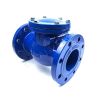Difference between lift check valve and swing check valve
The check valve is also called a one-way valve or a non-return valve. Its opening and closing is driven by the flow pressure of the medium in the pipeline. The main function is to prevent the medium from flowing back, and at the same time prevent the pump and motor from reversing, eliminate water hammer phenomenon, etc.
There are lift check valves, swing check valves, ball check valves, wafer check valves, axial flow check valves, diaphragm check valves, etc.
1. Lift check valve
The structure of the lift check valve:
It is mainly composed of valve body, valve seat, valve cover, valve disc and other parts.
The valve disc moves along the middle cavity of the valve body. The valve disc opens under the action of the fluid pressure at the inlet end, and the medium flows from the inlet end to the outlet end. When the pump is stopped, the inlet pressure is lower than the outlet pressure. The valve disc automatically closes under the action of the medium pressure difference, its own weight and other factors to prevent the medium from flowing back.
The lifting check valve is mainly divided into two categories according to the installation method: horizontal and vertical.
Straight-through horizontal lift check valve, the medium inlet and outlet flow direction is perpendicular to the valve seat channel direction.
DN15-DN300. Generally can only be installed in horizontal pipelines, there are also direct-flow horizontal lift check valves, the flow direction is inclined at a certain angle with the valve seat channel, which reduces the flow resistance compared to the straight-through lift type.
Vertical lift check valve, the medium inlet and outlet flow direction is the same as the valve seat channel direction, and its flow resistance is slightly smaller than the straight-through type. Diameter DN15-DN300. Generally installed on a vertical pipeline where the medium flows from bottom to top.

2. Swing check valve
Structure of swing check valve:
Mainly composed of valve body, valve seat, valve cover, valve disc, rocker, pin shaft and other parts.Because the flow channel in the valve is basically in a straight line, the flow resistance is smaller than that of the lift check valve, which is suitable for large-caliber occasions, but not suitable for pulsating flow, and its sealing performance is not as good as the lift check valve. According to the valve disc structure, it is divided into single-flap swing check valve, double-flap swing check valve, and multi-flap swing check valve.
Single-flap swing check valve is suitable for large and medium diameters. Large-diameter single-flap swing check valves mostly adopt slow-closing structure. Reduce medium water hammer phenomenon, DN50-DN600.
Double-flap swing check valve is suitable for large and medium diameters, double-flap swing check valve with short structure length and light weight, and slow-closing structure can also be adopted. DN50-DN1200.
Related links:Internal Hex Screws vs. Standard Screws: Pricing in Chile
Top Tips for Exporting Conveyor Connecting Clamps Effectively
Key Applications of Pump Bodies in Various Industries
Key Factors in Sourcing Raw Castings for Export
Why Choose a Trusted Pulley Exporter for Your Needs?
Revolutionize Your Production: Top Raw Casting Solutions Explained
2024 Guide to Internal Hex Screw Price in Saint Lucia
Swing check valves are mainly used on horizontal pipes and can also be used on vertical pipes. When used on vertical pipes, the medium must flow from bottom to top.
Vertical swing check valves are suitable for the end of the suction pipe of the pump and are only suitable for vertical pipes.
What are the differences between a Ductile Iron Swing Flanged Check Valve and a lift check valve:
1. Different valve structures
The structure of a swing check valve is a swing structure with an internal rocker arm. All the opening and closing parts of the valve are installed
inside the valve body and do not penetrate the valve body. The connection between the arm and the valve disc adopts a spherical connection structure, which allows the valve disc to have a certain degree of freedom within a 360° range and has appropriate micro-position compensation.
The valve body of the lift check valve is similar to the structure of the stop valve. There is a guide groove on the valve cover for the valve disc to move up and down, and the valve disc can be raised and lowered freely. The valve disc can be spherical or plunger-shaped. The valve disc can also be installed with a spring to reduce the opening impact force and assist the valve disc to close quickly, but the opening flow resistance increases.
2. Different applicable installation pipelines
The swing check valve can be installed on both horizontal and vertical pipelines. When installed on a vertical pipeline, the medium flow direction should flow from bottom to top.
Straight-through lift check valves can only be installed on horizontal pipelines, while vertical lift check valves are installed on
vertical pipelines. The medium flows from bottom to top.
3. Different flow resistance of the medium
When the diameter is above DN50, it is more energy-saving to use a swing check valve with a small pressure drop.
The channel of the straight-through horizontal lift check valve is an S-shaped bend, while the flow channel of the Disai swing check valve is close to a straight line.
Therefore, the flow resistance of the straight-through horizontal lift check valve is greater than that of the swing check valve. The flow channel of the direct-flow lift check valve is also basically a straight line, which effectively reduces the flow resistance.
Trapezoidal Lead Screw vs. Screw Nut: Which Is Better?
Motor Housing vendor
OEM castings factory
Key Considerations for Purchasing Fuji SMT Feeders
Top 10 SMT Machine Accessories to Boost Your Production Quality
Maximize Yamaha SMT Nozzle Efficiency: Tips & Troubleshooting
Are Fuji Xpf Cover Spare Parts Difficult to Find and Replace?

